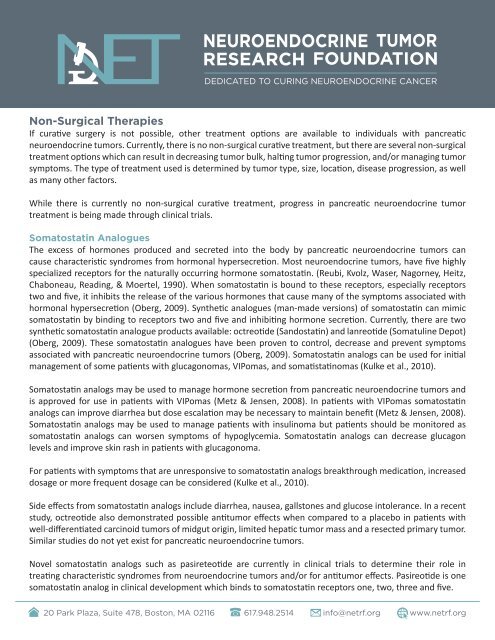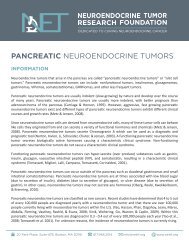PANCREATIC NEUROENDOCRINE TUMORS
You also want an ePaper? Increase the reach of your titles
YUMPU automatically turns print PDFs into web optimized ePapers that Google loves.
Non-Surgical Therapies<br />
If curative surgery is not possible, other treatment options are available to individuals with pancreatic<br />
neuroendocrine tumors. Currently, there is no non-surgical curative treatment, but there are several non-surgical<br />
treatment options which can result in decreasing tumor bulk, halting tumor progression, and/or managing tumor<br />
symptoms. The type of treatment used is determined by tumor type, size, location, disease progression, as well<br />
as many other factors.<br />
While there is currently no non-surgical curative treatment, progress in pancreatic neuroendocrine tumor<br />
treatment is being made through clinical trials.<br />
Somatostatin Analogues<br />
The excess of hormones produced and secreted into the body by pancreatic neuroendocrine tumors can<br />
cause characteristic syndromes from hormonal hypersecretion. Most neuroendocrine tumors, have five highly<br />
specialized receptors for the naturally occurring hormone somatostatin. (Reubi, Kvolz, Waser, Nagorney, Heitz,<br />
Chaboneau, Reading, & Moertel, 1990). When somatostatin is bound to these receptors, especially receptors<br />
two and five, it inhibits the release of the various hormones that cause many of the symptoms associated with<br />
hormonal hypersecretion (Oberg, 2009). Synthetic analogues (man-made versions) of somatostatin can mimic<br />
somatostatin by binding to receptors two and five and inhibiting hormone secretion. Currently, there are two<br />
synthetic somatostatin analogue products available: octreotide (Sandostatin) and lanreotide (Somatuline Depot)<br />
(Oberg, 2009). These somatostatin analogues have been proven to control, decrease and prevent symptoms<br />
associated with pancreatic neuroendocrine tumors (Oberg, 2009). Somatostatin analogs can be used for initial<br />
management of some patients with glucagonomas, VIPomas, and somatistatinomas (Kulke et al., 2010).<br />
Somatostatin analogs may be used to manage hormone secretion from pancreatic neuroendocrine tumors and<br />
is approved for use in patients with VIPomas (Metz & Jensen, 2008). In patients with VIPomas somatostatin<br />
analogs can improve diarrhea but dose escalation may be necessary to maintain benefit (Metz & Jensen, 2008).<br />
Somatostatin analogs may be used to manage patients with insulinoma but patients should be monitored as<br />
somatostatin analogs can worsen symptoms of hypoglycemia. Somatostatin analogs can decrease glucagon<br />
levels and improve skin rash in patients with glucagonoma.<br />
For patients with symptoms that are unresponsive to somatostatin analogs breakthrough medication, increased<br />
dosage or more frequent dosage can be considered (Kulke et al., 2010).<br />
Side effects from somatostatin analogs include diarrhea, nausea, gallstones and glucose intolerance. In a recent<br />
study, octreotide also demonstrated possible antitumor effects when compared to a placebo in patients with<br />
well-differentiated carcinoid tumors of midgut origin, limited hepatic tumor mass and a resected primary tumor.<br />
Similar studies do not yet exist for pancreatic neuroendocrine tumors.<br />
Novel somatostatin analogs such as pasireteotide are currently in clinical trials to determine their role in<br />
treating characteristic syndromes from neuroendocrine tumors and/or for antitumor effects. Pasireotide is one<br />
somatostatin analog in clinical development which binds to somatostatin receptors one, two, three and five.<br />
20 Park Plaza, Suite 478, Boston, MA 02116 617.948.2514 info@netrf.org www.netrf.org
















